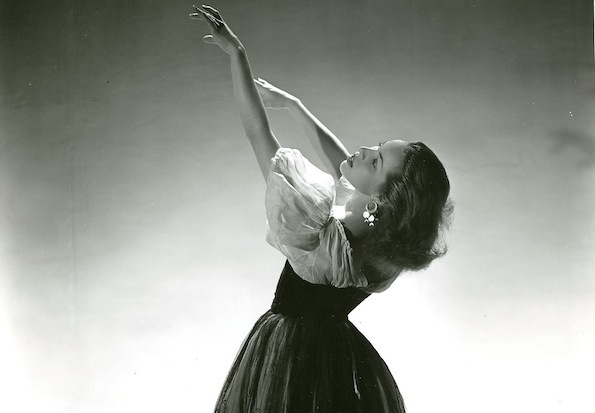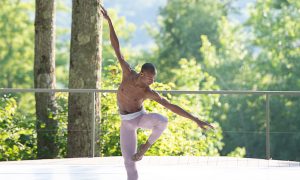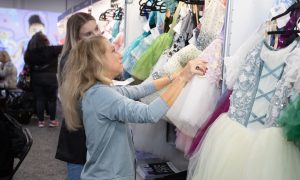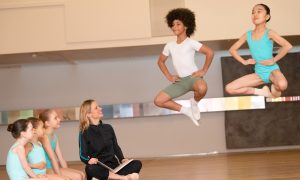One organization seeks to steward dance history preservation today
By Chelsea Thomas.
Modern dance pioneer Ted Shawn once said, “Dance is the only art of which we ourselves are the stuff of which it is made.” Perhaps it is this physical, ever-changing, in-the-moment quality of dance’s nature that poses the biggest challenge to dance historians today.
While sculptors have their statues, painters their paintings, photographers their images, musicians their scores and even playwrights their scripts, dancers and choreographers usually only have their memories, or at best, a video file which gets thrown into a unorganized computer folder or onto a messy storage shelf. So, the question is posed – is dance a vanishing art? Is this living art as temporary as the bodies which perform it?
If some have their doubts, there is a faithful group of renowned colleagues that hold out in confidence – the Dance Heritage Coalition. As the sole national non-profit seeking to preserve and create access to America’s dance history legacy, the Dance Heritage Coalition is made up of scholars, professors, archivists and dance enthusiasts working to preserve dance.
Operating as a network of dance resources and organizations, the coalition was first assembled in the early 90s to address problems in documenting dance and preserving the record, issues which were identified in a study commissioned by The Andrew W. Mellon Foundation and the National Endowment for the Arts. Officially founded in 1992, the coalition has now been grounded in two decades of documenting, preserving and enhancing national records.
Libby Smigel, Executive Director of Dance Heritage Coalition, says, “Compared to other performing arts, like music, theater and visual arts, dance in academe is still so young and with few textbooks and resources. When it comes to dance, we rely so much on the moving image, and as a result our dance history textbooks suffer because they rely on the limited commercial sources available.”
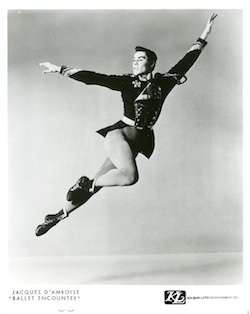
Former New York City Ballet Principal Dancer Jacques d’Amboise in ‘Ballet Encounter’. Photo courtesy of the Ann Barzel Dance Research Collection at The Newberry Library in Chicago.
To address the issues of lost and forgotten dances, poorly recorded choreography, missing company records and disorganized archives, the coalition is proactively encouraging, initiating and developing collaborative projects among the dance communities, libraries and archival fields.
The coalition seeks to teach companies, libraries, individuals and other dance communities the four essential needs of ongoing dance history preservation: access to materials, the continuing documentation of dance employing both traditional methods and developing technologies, preservation of existing documentation, and education within and beyond the field of dance.
“When you think of how every year most dance companies produce numerous new works and so many people are unable to travel to see them, its crazy how much is being missed because we can’t access it as easily as other art fans who can just download content online. So, we’re looking to encourage companies to release these materials more and to look at ways of digitalizing works,” Smigel explains.
While the coalition is focusing on the future of dance preservation, it is also mindful of all the work that still needs to be done in discovering, redeeming and preserving the past. After 20 years of aiding collections in organizing and accessing materials, the coalition is still seeing dance relics unearthed or recovered. One example of this is recent finds in the storage warehouse of the Dance Theatre of Harlem. One find was a rare costume from an early Firebird production.
Smigel recalls, “We also discovered the basic raw footage that documented the company’s trip to South Africa after Apartheid. They were the first dance company of their kind to go and perform in South Africa…which is an exciting cultural moment, and not just for dance but for general history as well. That is clearly an interesting and significant moment during that time of political change.”
Another momentous find was an old Eiko & Koma film. Smigel says, “We discovered the earliest existing film footage of Eiko & Koma performing before they came to the U.S. It has no sound and it shows their early movement vocabulary. It shows the early track of their dancing, which has now developed into their performances today.”
To young dancers thinking dance history preservation is irrelevant to their daily grind, Smigel emphasizes the importance of good organizational practices, saying, “The time to start organizing is now.”
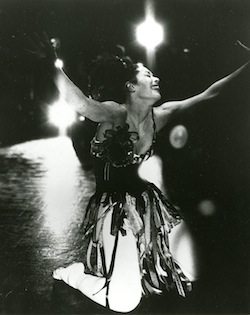
Carmen de Lavallade in ‘Pierrot Lunaire’, a ballet inspired by the characters of the ‘commedia dell’arte’, with the Glen Tetley Dance Company. Photo courtesy of the Ann Barzel Dance Research Collection at The Newberry Library in Chicago.
“Young dancers can become good stewards of the dance history they possess. From autographed pictures, broken-in pointe shoes and other mementoes, they can learn how to preserve and collect dance relics properly. These mementos can help to trigger memories of the artistic and cultural transmission one day,” Smigel says.
Just this month, the coalition has released “The Artist’s Legacy Toolkit”, which is an online set of tabs for those wondering about how to best save and organize video files, choreographic notes and so on. “It [is] geared toward the various levels of dancers – from early career dancers to late career dancers. There are tips for different stages,” describes Smigel.
Meanwhile, the coalition is also working to offer accessible dance history resources online for dancers and students. One extraordinary way in which this is achieved is through the feature America’s Irreplaceable Dance Treasures: the First 100. Smigel says, “This is a great place for young dancers to start to discover what DHC has to offer.” Each designated “irreplaceable dance treasure” includes a scholarly article, a photo and often, a video clip.
As two examples of designated dance treasures themselves, two other phenomenal online dance history resources are offered by Jacob’s Pillow Dance Festival and The Jerome Robbins Dance Division of The New York Public Library.
Jacob’s Pillow Dance Interactive, a free video resource curated by America’s longest running dance festival, Jacob’s Pillow Dance Festival, offers a glimpse into the treasure trove of archival footage and photographs housed at the Pillow’s physical archives. With all footage recorded at Jacob’s Pillow, this public project of the Virtual Pillow initiative is able to share a taste of the Jacob’s Pillow significant history while spreading an appreciation for dance.
Norton Owens, Director of Preservation at Jacob’s Pillow Dance Festival, says the idea for Jacob’s Pillow Dance Interactive “came from wanting to find more ways to share our resources.”
“We wanted to find a way to share our resources online that is consistent with the character of Jacob’s Pillow – we are very accessible, welcoming and user-friendly.”
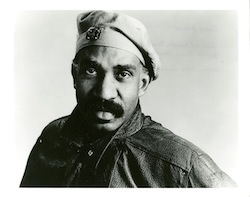
Portrait of modern dance choreographer Garth Fagan by Annie Lennox. Photo courtesy of the Ann Barzel Dance Research Collection at The Newberry Library in Chicago.
On the website, visitors can choose one of three basic features to view festival footage – artist, genre or era. Visitors can also select “Dive In” to have random content selected for them or “Guess” for a dance trivia game that allows users to match performance footage with the artists performing it.
“Because we have such a wide palette of performances taking place here from all over the world, both in the past and ongoing, we have amazing footage of dance unique to just the Pillow. This offers either a completely new experience or a way to see beloved companies and dancers in a setting you’ve never seen them in before,” Owens says.
Likewise, another vital resource to developing dancers, college majors, teachers, professors and scholars is the Jerome Robbins Dance Division of The New York Public Library. This is the largest and most comprehensive archive in the world devoted to the documentation of dance.
“Chronicling the art of dance in all its manifestations – ballet, ethnic, modern, social, and folk – the division is much more than a library in the usual sense of the word,” explains Curator Jan Schmidt, also president of the Dance Heritage Coalition. “It is part museum, part film production center and part consulting service to the professional dance community. It preserves the history of dance by gathering diverse written, visual, and aural resources, and it works to ensure the art form’s continuity through an active documentation program.”
Founded in 1944, the Dance Division can provide users everything from directions on how to reconstruct an Elizabethan court dance to watching dance from the provinces of Guinea, and biographies on the modern dance styles of Isadora Duncan, Martha Graham, and Doris Humphrey. The Dance Division is free and open to the public from all over the world.
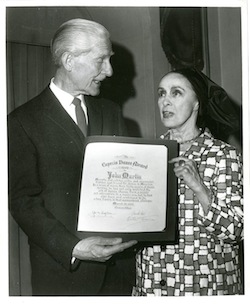
John Martin with Martha Graham receiving the Capezio Award in 1969. Photo courtesy of the Ann Barzel Dance Research Collection at The Newberry Library in Chicago.
In addition to physical resources galore, the Dance Division has its Oral History Archive and Project, which offers online clips of select interview recordings with more than half a century of performers, choreographers, scholars and producers. Schmidt added that in September the division plans to have a Dance Digital site so materials for which they have the rights “will be freely available on the web.”
So, with this plethora of resources in mind, is there room to fear the adequate preservation of dance history? Perhaps if dancers and companies don’t take the proper steps to organize and archive ongoing works – then yes. But, in general, no – not with the Dance Heritage Coalition and the stellar libraries, collections and resources seeking to preserve and provide access to dance history today.
Smigel says, “As long as we want dance to thrive and be visual in the public sphere, we are going to have to work together so that we can really create and communicate the context for dance.”
For more information on the Dance Heritage Coalition, visit www.danceheritage.org.
To access the DHC’s America’s Irreplaceable Dance Treasures: the First 100, visit www.danceheritage.org/treasures.html.
To experience Jacob’s Pillow Dance Interactive, see danceinteractive.jacobspillow.org.
For more information on the Jerome Robbins Dance Division of The New York Public Library, visit www.nypl.org.
Photo (top): Maria Tallchief in George Balanchine’s Le Baiser de la Fée. Photo courtesy of the Ann Barzel Dance Research Collection at The Newberry Library in Chicago, which is a member organization of the Dance Heritage Coalition.


